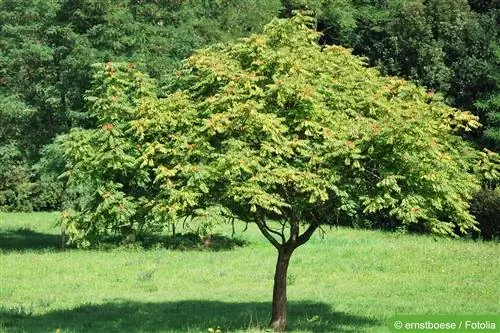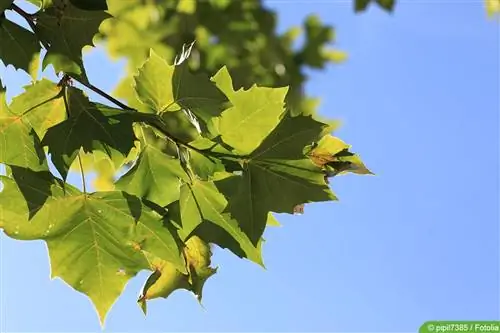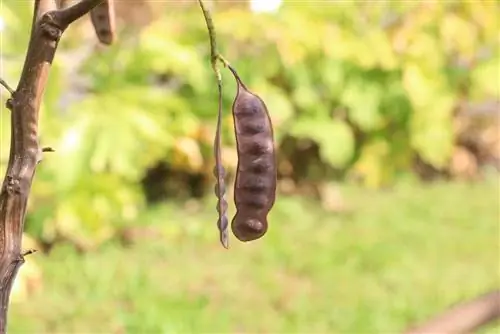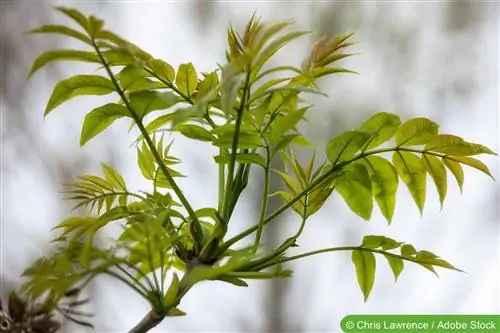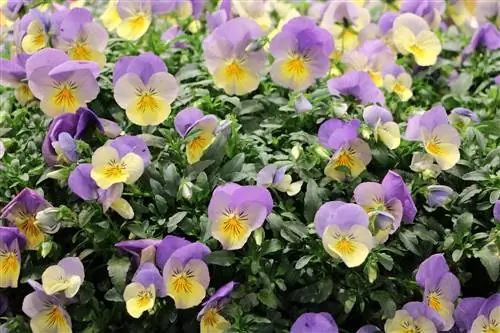- Author admin [email protected].
- Public 2023-12-17 03:39.
- Last modified 2025-01-24 12:45.
The tree of heaven is not only the fastest growing deciduous tree in Europe, but also impresses with its dense, high crown with decorative pinnate leaves and red cluster-like fruits. It thrives on all types of soil and places few demands on its location. The deciduous tree, which comes from China and East Asia, is poisonous in all parts. In favorable locations, seedlings grow up to one meter high in the first year. However, growth slows noticeably with age. Trees of heaven grow to a height of between 25 and 30 meters and are 100 to 150 years old.
Profile
- belongs to the bitter ash family, the genus Ailanthus and the species Altissima
- Origin in Asia
- after 10 years the tree is 5 meters high, after 20 years it reaches a height of 22 meters
- the final height is around 30 meters
- Growth per year 25 cm to 50 cm
- life expectancy is 100 to 150 years
- its bark is grey-brown with a diamond pattern
- hairy green branches, reddish-brown branches without hair when old
- two-sex
- pinnate leaves with up to 25 pairs of leaves
- Intensely smelling male flowers from July attract insects
- nut-like seed heads
- summergreen
- deciduous
- Roots form runners
- poisonous
- Solitary plant and shade provider
Location & Soil
The warmth-loving tree of heaven prefers a sunny location. Due to its spread, care should be taken to ensure sufficient distance from streets and neighbors. The fast-growing tree can cope with any soil. The more nutrient-rich the soil, the stronger the growth. But even on barren and nutrient-poor soils, the tree of heaven can grow up to 20 meters high. The ornamental tree is ideal for the city. Air pollution and exhaust fumes from industry and traffic don't bother him. It is resistant to road s alt, herbicides and drought.
Purchasing criteria
Since the tree of heaven grows quickly, small trees can also be considered for purchase. They get used to their new location better and faster than older trees. Protective bandages around the trunk should be removed before purchase to ensure uninjured bark. The ideal root system of the young tree spreads out in a radial manner. The roots should not curl.
Plants
The tree of heaven can in principle be planted all year round. To prevent the young shoots from freezing, the ornamental tree should not be planted in late autumn when frost is already imminent. Before planting, the tree is watered thoroughly. To do this, the root ball is completely immersed in a container of water and left there until no more air bubbles appear. This is how it's done:
- Dig a planting hole twice the size of the root ball
- Place drainage made of gravel or pottery shards into the planting hole
- Mix the excavated material with horn shavings or garden compost
- apply a layer of the mixed excavation over the drainage
- Place the god's tree in the planting hole and fill the planting hole with the remaining excavation
- position three support posts around the seedling and tie the tree with wide ribbons
- Tamp down the ground and top up with soil if necessary
- spread a layer of bark mulch to protect against drying out
- Water the tree thoroughly
Tip:
The support posts can be removed in the third year.
In order to limit the spread of the tree of heaven, which also occurs via root shoots, a barrier can be installed in the planting hole. Professional root barriers consist of a waterproof and frost-resistant geotextile that can withstand the enormous pushing force of the roots. It is placed around the seedling like a ring and closed using a click system. Attention: Do not place the ring too tightly in the seedling!
Care
The care measures for the tree of heaven are not very intensive. The tree should be watered regularly in the first two years. Intense sunlight should be avoided during the growth phase. To do this, the trunk is wrapped with protection made of bamboo mats. Due to the immense growth, the connection to the support piles must be checked from time to time and replaced if necessary. Winter protection is necessary in the first few years. An adult tree of heaven can tolerate severe frost down to around -20 °C.
Tip:
The bark of the tree of heaven can crack due to excessive sunlight and is then a gateway for pests and diseases.
Diseases
The poisonous tree of heaven contains many bitter substances and is therefore largely avoided by plant pests. Only the Ailanthus moth has specialized in the leaves of the tree as a source of food. Gray mold rot often occurs in stands that are too dense due to the lack of air circulation. Then the young shoots and non-woody parts of the tree die. The use of chemical control agents for gray mold rot is prohibited in private gardens.
Cutting
- remove twos growing inwards
- cutting off dead wood
- remove crossing branches
- when shortening the shoots, cut directly above a bud
Tip:
Do not leave any stubs and do not cut into the branch! When cutting, you should definitely wear safety glasses and gloves because of the toxicity.
Propagate
The tree of heaven can be propagated by shoots and seeds. For propagation via shoots, a young shoot with three to four pairs of leaves is cut off. It is rooted in potting soil or in a glass of water. Roots form within a very short time. The tree of heaven can then be planted in its future location. Propagation by seeds can occur in autumn when the seeds ripen on the fruit heads. The seeds are planted in a container with potting soil. The young shoot is overwintered frost-free and planted outdoors in spring.
Tip:
Due to its growth rate, the tree of heaven is easy to propagate.
Consider before buying
The tree of heaven is already on the “black list” because it spreads uncontrollably in many places through the seeds that the wind carries hundreds of meters away. It displaces native plants and harbors new allergy potential.
Frequently asked questions
How did the divine tree get its name?
The tree of heaven was given a name because of its rapid, emerging growth. In some areas the tree is also called the “tree of heaven”. In northern China, the divine tree is also called the “spring tree” because it sprouts after winter.
What crown shape is typical for the tree?
This can be influenced individually through a targeted cut. Wild-growing trees of heaven have a broad crown and often have two trunks.
Why is planting a tree of heaven often discouraged?
It multiplies very quickly in the garden, sows itself and sprouts. Within a year, the number of shoots in older trees can reach 30, which quickly grow up to two meters high.
What you should know about the tree of heaven in brief
- A tree of heaven is a very fast-growing and beautiful tree, but it is now classified as an invasive plant.
- Which displace native species and thereby disrupt the ecological balance.
- It also causes he alth problems for people and is therefore better not to be planted in your own garden.
Origin and spread
- The tree of heaven (Ailanthus altissima) comes from China and Vietnam and from there spread all over the world.
- It grows best in warm countries, but also in urban areas.
- It requires almost no care, grows extremely quickly and can reach heights of up to 30 meters in a good location.
- From June to July, yellow flowers appear on this tree, which are in long panicles and have a rather unpleasant smell.
- The tree of heaven spreads through root shoots that form on the roots near the surface.
- They can occur many meters away from the tree.
- In parallel, propagation takes place by seeds.
Fighting the Tree of God
- Although the tree of heaven is a beautiful tree in itself, it is considered by many experts to be an invasive plant.
- It spreads widely through underground roots and seeds and is difficult to remove.
- In some European countries, wild trees of this type are removed to prevent further spread.
- In Austria and Switzerland, the tree of heaven is already on the black list of invasive neophytes and is being systematically combated.
- In addition, the seeds are poisonous, the bark and wood can cause allergic reactions when touched.
- Sensitive people also react allergically to the pollen. Therefore, it is worth considering planting another tree in the garden.
Tip:
The felling of an existing tree of heaven, on the other hand, is best left to a specialist company. He alth problems often arise, especially when felling, so protective clothing is definitely recommended.

